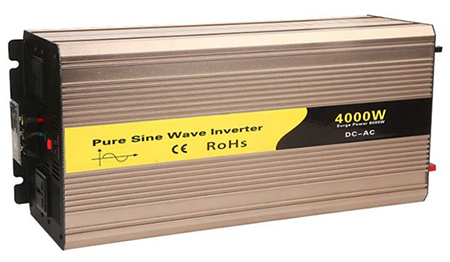Sine wave inverters are widely used in various applications, including renewable energy systems, uninterruptible power supplies (UPS), and consumer electronics. They convert direct current (DC) to alternating current (AC) by generating a sinusoidal waveform, which closely resembles the power supplied by utility grids. One of the critical components in these inverters is the inductor, which plays a significant role in filtering and shaping the output waveform.
Inductor heating is one of the common faults in the use of sine wave power inverters. There are two problems resulting to inductor heating: excessive loss on the inductor and poor heat dissipation conditions. The best way to solve the serious problem of heating is to start from the perspective of loss (inductance loss and magnetic core loss). In the following, Inverter Store will explain in detail.
Reason 1 for inductor heating of sine wave inverter: the loss of inductor.
The loss of inductor is mainly composed of two parts, one is the loss caused by the coil resistance, and the other is the loss caused by the magnetic core. The loss on the coil is related to the coil resistance and current, the formula is: Pwire=I x I x R
In general, the current cannot be reduced, so we can only find a way from the coil resistance. The measures taken are as the following:
- Increase the wire diameter. This method may be limited by the shape and size of the magnetic core, which will be too thick to be wound.
- Shorten the length of the wire. This method will decrease the inductance under the condition the magnetic core material is unchanged. If you want to keep the same inductance, the core with a higher permeability needs to be replaced.
- If the inductor is working under the condition of high frequency, it will have a skin effect on the wire, that is, the current flows on the surface of the wire, so the utilization rate of the wire is too small. The method that can be considered is to change the single-stranded wire of sine wave inverter to multi-stranded wire parallel winding, which can also reduce the loss of the coil.

Reason 2 for inductor heating of sine wave inverter: the loss of magnetic core.
The loss of magnetic core is mainly composed of hysteresis loss and eddy current loss. The hysteresis loss is related to the hysteresis loop of the magnetic core material, and is proportional to the size of the enclosed area. Br is the remanence and Hc is the coercive force, which are two inherent characteristics of the magnetic core. The two parameters will be determined after the magnetic core is selected.
The maximum magnetic flux density B and the maximum magnetic field strength H are related to the working state of the circuit. By reducing the ripple current of the inductor, the inductor's hysteresis loss can be reduced. Under the condition that the inductance is certain, the increase of the frequency will be required by reducing the ripple current, but the increase of the frequency will increase the core loss.
Minimizing these losses is crucial for improving the efficiency of sine wave power inverters. This can be achieved by selecting core materials with lower hysteresis and eddy current losses, optimizing the core design, and employing advanced cooling techniques. Understanding and mitigating magnetic core losses are essential for enhancing the performance and longevity of sine wave inverters.
In summary, each corresponding method will always cause the deterioration of the other, so there must be a comprehensive trade-off, and needs to be tested and determined. The above only provides some possible methods that may reduce the inductance loss.
Reason 3 for inductor heating of sine wave inverter: heat dissipation conditions.
In solar sine wave inverters, inductors can heat up significantly due to inadequate heat dissipation conditions. When inductors are operating, they generate heat as a result of the resistance in the wire windings and core losses. If the heat generated is not effectively dissipated, it accumulates, causing the temperature of the inductor to rise.
Poor ventilation, insufficient cooling mechanisms, or an enclosure that traps heat can all contribute to inadequate heat dissipation. This can lead to higher operating temperatures, which not only affects the performance of the inductor but also shortens its lifespan. Ensuring proper heat dissipation conditions, such as using heat sinks, cooling fans, or ensuring adequate airflow, is crucial in preventing excessive heating of inductors in sine wave inverters.
Furthermore, the thermal management design must account for the worst-case operating conditions. This includes considering ambient temperatures, the inverter's load, and the duty cycle of operation. Effective thermal management helps maintain the efficiency and reliability of the sine wave inverter system, preventing thermal runaway and potential damage to the inductor and other components.
Conclusion:
Inductor heating in sine wave inverters can be a challenging issue to troubleshoot, but with a systematic approach, it can be effectively addressed. By understanding the causes of inductor heating and following the troubleshooting steps outlined in this article, you can identify and resolve the problem, ensuring the efficient and reliable operation of your sine wave inverter. Regular maintenance and preventive measures will further help in avoiding such issues in the future, extending the lifespan of the pure sine wave inverter and its components.
